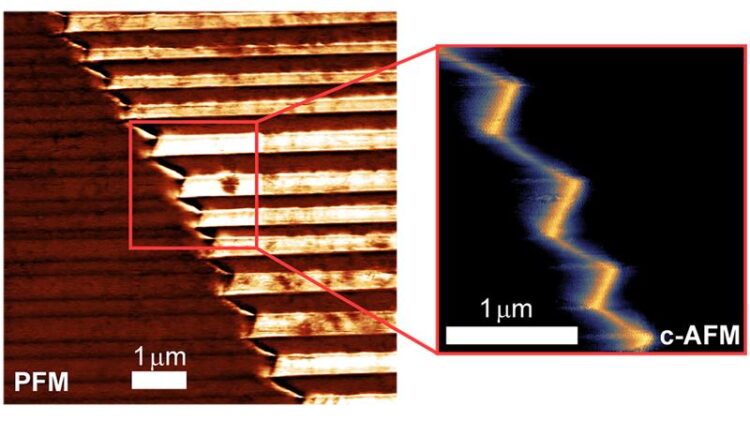Conductive domain walls with promising functionalities

A piecoelectric scanning electron microscope measuring showing a zigzag domain wall in GaV4S8 (left). Image of a conductivity microscope measuring showing the conductivity of the domain walls (right).
(c) Universität Augsburg
Researchers from the University of Augsburg and ETH Zurich have discovered giant conductivity of nanometre-sized domain walls separating polar regions in a non-oxide ferroelectric material. The high sensitivity of these walls to applied magnetic fields enables gigantic switching of the sample resistance, thus providing a route to new nanoelectronic building blocks. Such behaviour is unprecedented in non-oxides, which are less hampered by defects and deviations in composition than oxides.
Materials that exhibit a spontaneous electric polarization are called ferroelectrics. The polarization originates from the parallel alignment of electrical dipoles. Ferroelectrics are often composed of distinct regions, known as domains, which differ from each other by the orientation of their polarization. Domain walls are the thin, essentially two-dimensional interfaces that separate adjacent domains.
In recent years, researchers are intensely probing the properties of these domain walls, because of their ability to host unusual emergent phenomena, which are forbidden within the domains, and because of their potential applicability in future, nanometre-sized electronic components. Intriguingly, in some insulating ferroelectric oxides the domain walls were found to exhibit unusually high conductivity. Unfortunately, their functionalities are often hampered by the presence of defects and/or oxygen vacancies.
Left frame: A piezoresponse-force-microscopy image showing the zig-zag domain walls in GaV4S8. Middle frame: Conductive-atomic-force-microscopy image revealing the conducting nature of the domain walls. Right frame: Magnetic field driven extremely large change of the overall sample resistance caused by domain wall expulsion process.
In a recent article, published in Nature Communications, the research groups led by Professor István Kézsmárki of University of Augsburg, Germany, and Professor Manfred Fiebig of ETH Zurich, Switzerland, reported for the first time the existence of such highly conducting domain walls in a non-oxide ferroelectric material, GaV4S8. Though the volume fraction of these domain walls is negligibly small, they completely govern the overall conductivity of the material. Moreover, they exhibit fascinating geometrical arrangements, forming quasi one-dimensional conducting ribbons and two-dimensional folded, zig-zag shaped surfaces. In addition, conducting zig-zag domain walls exhibit head-to-head and tail-to-tail configurations of polarizations in the adjacent domains, and thus, may imply alternating electron- and hole-conduction channels, i.e. conduction of negative and positive charge carriers, within nanoscale proximity.
The conductive domain walls in this non-oxide material enable attractive and unique functionalities. Especially, they exhibit a giant variation of the conductivity when applying magnetic fields and, most importantly, also can be mobilized and completely erased by such magnetic fields. This domain-wall annihilation process results in an extremely large change of the overall sample resistance by about a factor of 108. These remarkable findings shall help in further exploring and understanding the rich domain-wall physics and may pave a way toward the utilization of domain walls in electronic devices of the future, like nanometric memory elements with high data capacity.
Wissenschaftliche Ansprechpartner:
Dr. Somnath Ghara
Academic staff
Experimental Physics V
Augsburg University
Phone: +49 821 598 – 3607
Email: somnath.ghara@physik.uni-augsburg.de
Originalpublikation:
Publication: Somnath Ghara, Korbinian Geirhos, Lukas Kuerten, Peter Lunkenheimer, Vladimir Tsurkan, Manfred Fiebig, István Kézsmárki, Giant conductivity of mobile non-oxide domain walls, Nature Communications 12, 3975 (2021).
https://doi.org/10.1038/s41467-021-24160-2.
Media Contact
All latest news from the category: Physics and Astronomy
This area deals with the fundamental laws and building blocks of nature and how they interact, the properties and the behavior of matter, and research into space and time and their structures.
innovations-report provides in-depth reports and articles on subjects such as astrophysics, laser technologies, nuclear, quantum, particle and solid-state physics, nanotechnologies, planetary research and findings (Mars, Venus) and developments related to the Hubble Telescope.
Newest articles

Innovative 3D printed scaffolds offer new hope for bone healing
Researchers at the Institute for Bioengineering of Catalonia have developed novel 3D printed PLA-CaP scaffolds that promote blood vessel formation, ensuring better healing and regeneration of bone tissue. Bone is…

The surprising role of gut infection in Alzheimer’s disease
ASU- and Banner Alzheimer’s Institute-led study implicates link between a common virus and the disease, which travels from the gut to the brain and may be a target for antiviral…

Molecular gardening: New enzymes discovered for protein modification pruning
How deubiquitinases USP53 and USP54 cleave long polyubiquitin chains and how the former is linked to liver disease in children. Deubiquitinases (DUBs) are enzymes used by cells to trim protein…


